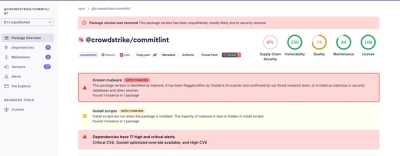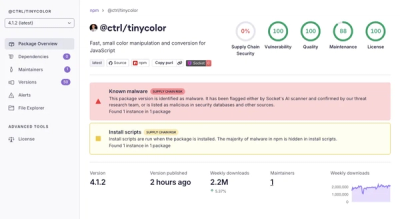buntstift
buntstift makes the CLI colorful.

Status
| Version |  |
| Dependencies |  |
| Dev dependencies |  |
| Build |  |
| License |  |
Installation
$ npm install buntstift
Quick start
First you need to integrate buntstift into your application:
const { buntstift } = require('buntstift');
If you use TypeScript, use the following code instead:
import { buntstift } from 'buntstift';
To show messages in the terminal, use the info function:
buntstift.info('Server started on port 3000.');
If you need to highlight messages, use success, error, and warn instead of info:
buntstift.success('Server started on port 3000.');
buntstift.error('Failed to start server.');
buntstift.warn('Server started, but without IPv6 support.');
Finally, there is also verbose to show messages meant for debugging or analysing application flow. Please note that by default, these messages are not shown in the terminal, unless you explicitly enable verbose mode:
buntstift.verbose('Verifying whether port 3000 is available...');
To show messages on the terminal without any support from buntstift, e.g. to pass through some already preformatted output, use the raw function:
const preformattedOutput =
buntstift.raw(preformattedOutput);
By default, raw writes to the application's standard output stream. Sometimes you want the message to go to the standard error stream instead. For that, provide an options object and specify stderr as the target:
buntstift.raw(preformattedOutput, { target: 'stderr' });
Prefixing messages
Except raw, all the aforementioned functions are able to show a prefix before the actual message, and some of them do so by default. To explicitly set a prefix, provide an options object and set its prefix property to the desired value:
buntstift.success('Server started on port 3000.', { prefix: 'OK' });
Configuring buntstift
Without any manual configuration, buntstift tries to use reasonable defaults. However, sometimes you may need to change its configuration. For that, first use the getConfiguration function to get the current configuration:
const configuration = buntstift.getConfiguration();
The configuration object now has a number of functions (see section below) to adjust the configuration. E.g., to disable colors, call the withColorLevel function and hand over ColorLevel.Disabled as parameter:
const updatedConfiguration = configuration.withColorLevel(ColorLevel.Disabled);
Please note that all of the functions on the configuration object do not mutate the configuration, but return a new instance instead!
Finally, set the new configuration using the configure function. Typically, because of the configuration object's immutability, you may want to do all of this in a single statement:
buntstift.configure(
buntstift.getConfiguration().
withColorLevel(ColorLevel.Disabled).
withUtf8(false)
);
Setting the colors level
By default, buntstift uses colors to show its messages. To explicitly disable colors or set a specific color level, use the withColorLevel function:
const updatedConfiguration = configuration.withColorLevel(ColorLevel.Disabled);
const updatedConfiguration = configuration.withColorLevel(ColorLevel.Ansi);
See the ColorLevel enum for all possible values.
Enabling or disabling interactive sessions
In interactive sessions the spinner is shown in the terminal, while in non-interactive sessions it is hidden. By default, buntstift tries to detect whether a session is interative or not. To explicitly enable or disable interactive sessions, use the withInteractiveSession function:
const updatedConfiguration = configuration.withInteractiveSession(true);
Enabling or disabling quiet mode
In quiet mode no messages are written to the terminal any more, except messages written using error, warn, and raw. By default, the quiet mode is disabled. To enable or disable quiet mode, use the withQuietMode function:
const updatedConfiguration = configuration.withQuietMode(true);
Enabling or disabling UTF8
By default, buntstift uses some UTF8 instead of simple ASCII characters. To enable or disable UTF8, use the withUtf8 function:
const updatedConfiguration = configuration.withUtf8(true);
Enabling or disabling verbose mode
In verbose mode, messages written using verbose are shown in the terminal, while in non-verbose mode, they are silently skipped. To enable or disable verbose mode, use the withVerboseMode function:
const updatedConfiguration = configuration.withVerboseMode(true);
Configuring individual messages
From time to time, you may want to change the configuration, but limit the effect of these changes to individual messages. For that, you can pass configuration options when calling buntstift functions. E.g., to disable UTF8 for a single message, use the following code:
buntstift.success('Server started on port 3000.', { isUtf8Enabled: false });
You may also pass the properties isColorEnabled, isInteractiveSession, isQuietModeEnabled, and isVerboseModeEnabled.
Using lines
To show a line, e.g. to separate two sections, use the line function:
buntstift.line();
To show a header, e.g. to denote the start of a new section, use the header function:
buntstift.header('Running tests...');
You may change the header's prefix using the prefix property mentioned above.
Using empty lines
To show an empty line, use the newLine function:
buntstift.newLine();
Using lists
To show a list in the terminal use list and provide a list item. Optionally, you may specify an indentation level. Setting the indentation level to 0 is equal to omitting it:
buntstift.list('foo');
buntstift.list('bar');
buntstift.list('baz', { level: 1 });
You may change the list item's bullet using the prefix property mentioned above.
Using tables
From time to time you need to show tabular data in the terminal. For that, use table and provide an array of objects to use as rows. The objects all must have the very same properties, i.e. they must match the same interface.
The keys of the row objects are rendered as table header in a human-readable way. The individual cells become padded automatically. Numbers are aligned to the right, anything else is aligned to the left:
buntstift.table([
[{ protocol: 'http', port: 80 }],
[{ protocol: 'https', port: 443 }]
]);
If you don't want to show the header, additionally provide an options object and set its showHeader property to false:
buntstift.table([
[{ protocol: 'http', port: 80 }],
[{ protocol: 'https', port: 443 }]
], { showHeader: false });
Waiting for long-running tasks
If your application performs a long-running task, you may want to show a spinner in the terminal. For that, call the wait function, which returns another function to stop the spinner at a later point in time. If you use any buntstift function while the spinner is active, buntstift will take care of disabling and re-enabling the spinner as needed, to avoid flickering:
const stop = buntstift.wait();
stop();
Please note that the spinner is written to the application's standard error stream, not to the standard output stream.
Getting user input
Besides the various ways to display information, buntstift is also able to get input from the user. For that, use the ask, confirm and select functions.
Asking a question
If you want to ask the user a question, use ask and provide a question:
const answer = await buntstift.ask('What do you want to do today?');
Optionally, you may specify a regular expression to use as a mask to match the answer against:
const answer = await buntstift.ask('What do you want to do today?', /.+/g);
Alternatively, you may specify a default value for the answer:
const answer = await buntstift.ask('What do you want to do today?', 'coding');
If you want to provide both, i.e. a mask and a default value, provide an options object:
const answer = await buntstift.ask('What do you want to do today?', {
mask: /.+/g,
default: 'coding'
});
To ask for a password, provide an options object and set the echo property to false:
const password = await buntstift.ask('Please enter your password:', {
echo: false
});
Getting a confirmation
If you want to get a conformation from the user, use confirm and provide a question:
const isSure = await buntstift.confirm('Are you sure?');
Unless specified otherwise, the default answer is true. To change this, provide false as second parameter:
const isSure = await buntstift.confirm('Are you sure?', false);
Selecting from a list
If you want the user to select a value from a list, use select and provide a question as well as a selection of choices:
const favoriteColor = await buntstift.select('What is your favorite color?', [
'red',
'green',
'blue'
]);
Chaining functions
If you want to run a number of buntstift functions as a sequence, you can chain them into a single call (as long as you limit yourself to the synchronous functions):
try {
} catch (ex) {
buntstift.
error('An unexpected error occured.').
info(ex.message).
verbose(ex.stack);
}
Running quality assurance
To run quality assurance for this module use roboter:
$ npx roboter








